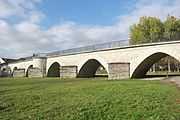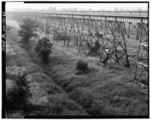Flood bridge
A flood bridge is a bridge that crosses the floodplain of a body of water. As a rule, it is part of the approach to the main bridge over the water as a fore bridge, but can also serve as an independent bridge, for example to cross a branch that only carries water during floods .
Structure and purpose
Flood bridges are approach bridges for the actual bridges that lead across bodies of water (e.g. rivers). Most of the time, the pillars are closer together than the bridge that spans the water. You will be over floodplains , z. B. meadows and floodplains. The floodplains are usually dry or moist with normal water levels in the rivers. If the water level of the river rises due to flooding e.g. B. by prolonged rain or meltwater , the river bed is no longer sufficient for the amount of water and the excess water fills the floodplain provided for this purpose. In this case, the surface of the water expands many times over. Due to the high flood bridge, the traffic route is passable despite the flood, since the water can flow under the flood bridge. In the event of extreme floods, bridges and flood bridges are closed to traffic, as a danger due to possible undercutting by the hydropower could damage the statics or the bridge could even be flooded.
The Waldau flood bridge spans an old arm of the Saale .
Trestle bridges of the Frisco Bridge and Harahan Bridge over the flood plain of the Mississippi



